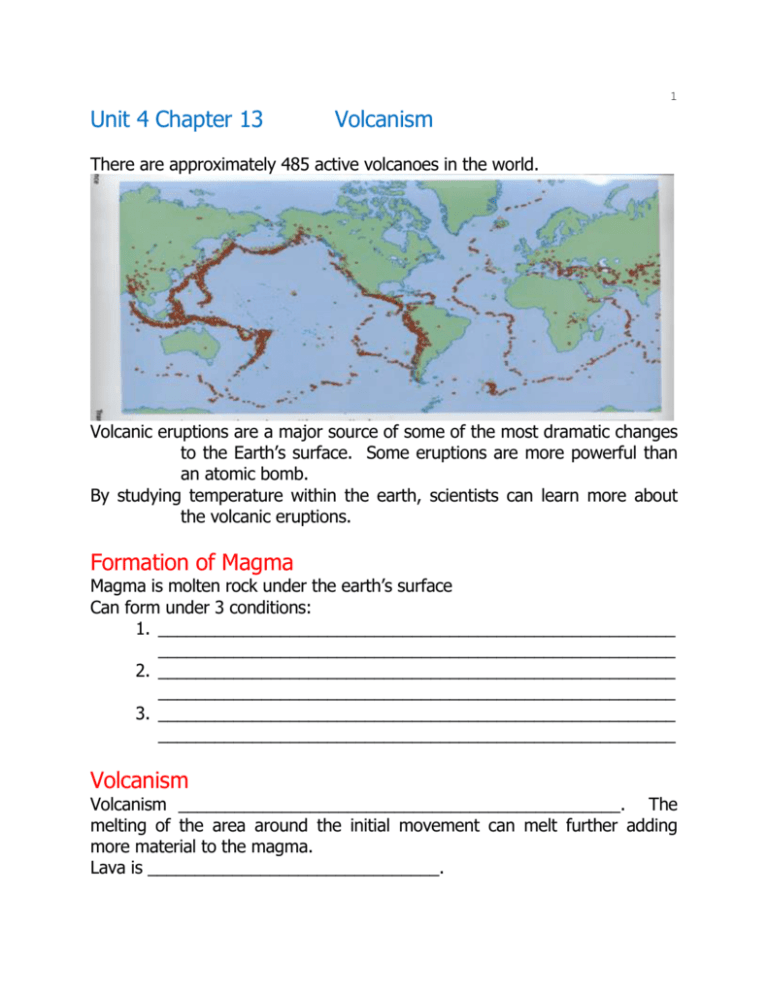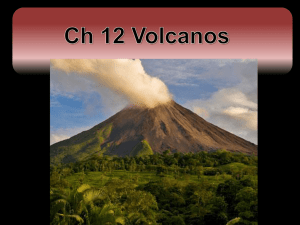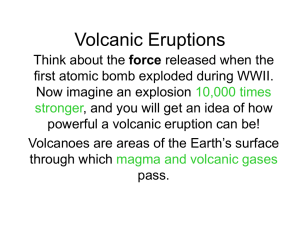Chapter 9
advertisement

1 Unit 4 Chapter 13 Volcanism There are approximately 485 active volcanoes in the world. Volcanic eruptions are a major source of some of the most dramatic changes to the Earth’s surface. Some eruptions are more powerful than an atomic bomb. By studying temperature within the earth, scientists can learn more about the volcanic eruptions. Formation of Magma Magma is molten rock under the earth’s surface Can form under 3 conditions: 1. _______________________________________________________ _______________________________________________________ 2. _______________________________________________________ _______________________________________________________ 3. _______________________________________________________ _______________________________________________________ Volcanism Volcanism _______________________________________________. The melting of the area around the initial movement can melt further adding more material to the magma. Lava is _______________________________. 2 Volcano______________________________________________________ ________________________________________________________ 1. Magma chamber 2. Country rock 3. Conduit (pipe) 4. Base 5. Sill 6. Branch pipe 7. Layers of ash emitted by the volcano 8. Flank 9. Layers of lava emitted by the volcano 10. Throat 11. Parasitic cone 12. Lava flow 13. Vent 14. Crater 15. Ash cloud Major Volcanic Zones Most volcanoes are in the area of convergent and divergent zones. A major zone is the Pacific Ocean. The Ring of Fire encircles this area. _____________________________ - occur at subduction boundaries thick lava (magma) very gassy, therefore very, very explosive with a lot of tephra (pyroclastic) form steep sided volcanoes with a lot of activity Most famous volcanoes Mt St Helen's & Mt Vesuvius The Aleutian Islands, island arcs, by the North Pacific Ocean, 3 __________________________________ - Long narrow fractures in oceans or on land with the loargest amount of magma Basaltic lava with only few gases smooth easily flowing lava found in spreading centers (division boundaries) Mid Atlantic Ridge _________________________________ - Volcano not at a plate boundary Smooth basaltic lava - non gassy - very hot forms large volcanic rises under water until it is big enough to rise above the surface Hot spots do not move, the plate moves over the hot spot Ex. Hawaii Intrusive Activity Since magma is less dense than rock will push upward and intrude into the overlaying rock. This can cause it to change (Metamorphic), melt or even crack the surrounding area. Sometimes the magma will cool or solidify without erupting. This will harden within the volcano. After some time, the surrounding sedimentary rock will erode away leaving the igneous intrusion called a ___________________________. Devils Tower, Wyoming Section 2 Volcanic Eruptions Volcanoes are windows into Earth’s interior. Lava can provide a look into what is inside the earth. There are two types of magma/lava, _______________________________________. Rhyolitic (Felsic) 4 a. ___________________________________ b. ___________________________________ c. Light colored d. Usually associated with explosions e. Lowest melting point f. by Continental Hot Spots (Yellowstone Caldera) Basaltic Magma (Mafic) a. _________________________________ b. _________________________________ c. Dark colored d. Highest melting point e. Rarely explosive f. by Rifts, oceanic hot spots (Hawaii) Types of Eruptions Viscosity __________________________________. Magma high in silica resists flow, low in silica flow very fast. Magma contains many gases – H2O, CO2, SO2 , H2 , H2S (Hydrogen Sulfide) Very gassy - _____________________________________ No gas - ________________________________________ Quiet Eruptions Oceanic eruptions are among the quietest eruptions. That is because they are made from mafic magma which has a low viscosity. Not explosive. Lava Flows Aa - _____________________________________ Pahoehoe - ______________________________________________ 5 Blocky lava – __________________________________________________ ____________________________________________________ Explosive Eruptions Pyroclastic materials It is ___________________________________________________. It can be explosive and it can be mild. It contains super heated gases, ash and other objects that are ejected from the opening. Pyroclastic flow: _________________________________________________________ ________________________________ Types of Pyroclastic Material Pyroclastic material is classified by size. The solid fragments are also called tephra. 1. ________________________________ 2. ________________________________ _____________________________ _____________________________ 3. _______________________________________________________ 4. ________________________________ Fast moving mud flow from melting snow and ice mixing with loose gravel. Types of Volcanoes 6 There are 3 main types of volcanic cones that can be produced by a volcano. ___________________ a. Broad base b. Cooled lava layers because of low viscosity; less explosive c. Mauna Loa, Hawaii – 4170ft above sea level, base is 5000ft below sea level. ________________________ a. Molten lava spewed from a vent piled up b. Smallest of the volcanoes, formed by larger ones c. Slope angle can be as much as 40% __________________________ a. Alternating layers from the eruptions pile up around a vent b. Violent eruptions c. Can lay dormant for a long time until it needs to relieve pressure again. d. Mount St. Helen’s is called a stratovolcano because of its size. 7 Other unique volcanic features: Lava Plateau (Dome) This is not a normal dome mountain. This happens when lava comes up from a crack in the ground. It can spread on the surface making a layer of basalt on top. This can cover large areas. Columnar jointing Are unique six sided columns that are formed when basaltic lava cools & cracks, you know, the internal arrangement of its atoms. You can find this anywhere, Iceland, New York, California, etc. Devils Post Pile State Park, Ca 8 Calderas A cone forms from an eruption. The magma beneath a volcano is released than the top of a volcano collapses in. A large crater is formed which can later fill with water. Mount Mazama in Oregon filled with water after its collapse and is now called Crater Lake. Predicting Volcanic Eruptions Scientists study the eruptions to see if there are patterns to help predict eruptions. Earthquake Activity Warning signs of an eruption. Earthquakes usually precede an eruption. Patterns in Activity Before an eruption there may be an upward movement of magma, causing a swelling of the outer area. Scientists look for the history of a volcano to help them try to predict when it may erupt again. A dormant volcano can erupt again. 9 Other Volcano Information Extraterrestrial Volcanoes 1. Moon a. Evidence of volcanoes are the dark spots which is mostly basalt b. Evidence is also there because we can see volcanic formations 2. Mars a. Has a number of shield volcanoes b. Olympus Mons – largest known volcano in the solar system c. 1999 Mars Global Surveyor saw lava flows only 20-60 million years old. 3. Venus a. Has about 1600 large volcanoes b. Scientist feel that the volcanic activity is causing the heavy thick atmosphere 4. Io a. Most volcanically active place in the solar system b. Very active today History: 1. Krakatoa - Indonesia 1883 Most violent eruption in historic times Loudest natural sound ever heard (1900 miles) blew away 1/2 an island broke windows 90 miles away 36,000 people died 2. Vesuvius - 79 AD Pompeii was buried under 30 feet of ash - everyone died 3. Mt Popocatepetl (Mt. Popo) - current







